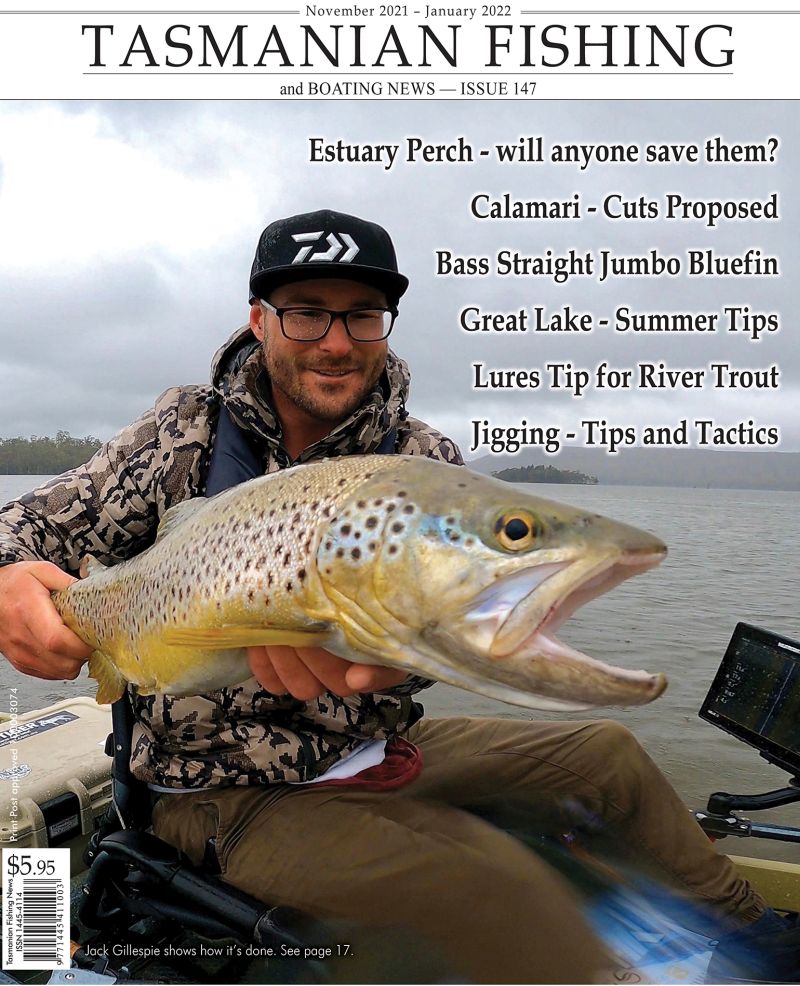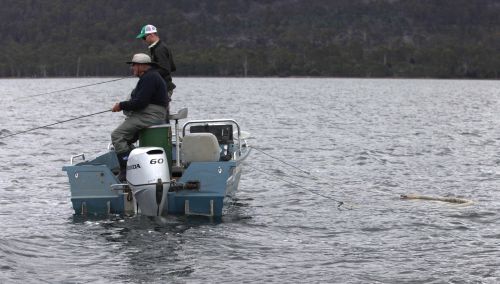 Presented from Issue 98
Presented from Issue 98
Wish list, bucket list, call it what you will, I think most of us have one. They seem to come about from conversations with other anglers about different places they have fished, things we have seen on TV or articles we have read in publications such as this one. Some of far-flung places and exotic species but others a little less expensive. This is certainly the case with me; some things just stick in my mind. An article I read many years ago by a well-known fishing journalist whose face adorns many soft plastic packets was fishing for garfish on fly. This undertaking was purely about familiarisation with his fly rod, before he went on a trip to New Zealand. It started out with some burley on the water to attract garfish in an estuary close his home and culminated in him standing up to his crown jewels, in his underwear, with two garfish stuffed down the back of his jocks and a fly hook firmly stuck in his finger. It was more than just the humour of the article that stuck with me and with my interest piqued, I told myself I’d have a crack at garfish on fly one day but I’d give the fish down the back of the jocks a miss! Fifteen years later Jamie Henderson asked me if I would like to spend the afternoon on George’s Bay chasing garfish. “Here is a chance to tick one off the bucket list” I thought and eagerly accepted.
When I arrived at Akaroa Beach Jamie had already launched the boat and was ready to go. I grabbed my gear, jumped in and we slowly motored a few hundred metres across the channel to the calmer shore opposite stock yard flats. After a torrential downpour in the morning the afternoon had calmed off and come out quite nice, consequently we had the place to ourselves. The tide was starting to run in as we arrived, so we dropped anchor about 30 metres back from the channel edge in about two metres of water. A combination of seagrass and sand is best. The anchor rope was kept as short as possible to prevent the boat from swinging too much. If the boat does swing a lot it tends to spread the burley out too much. It is much easier if you can keep the fish concentrated, close to the back of the boat. On windy days a second anchor to prevent excessive swinging is a big help.
For burley Jamie was using a pre-packaged breadcrumb type burley that came impregnated with aniseed. To this he added a small amount of tuna oil. He placed it all in a slotted burley bucket, one that you can adjust the flow rate with a simple twist; he also added a large snapper sinker before replacing the lid. This was tied on about a metre of rope and the sinker helped to keep the burley bucket about mid- water, directly below the back of the boat. It seems best to just put out a very small amount in a continuous trail rather than a lot which can be carried away with the current and hold the fish too far away from the boat or over feed the fish.
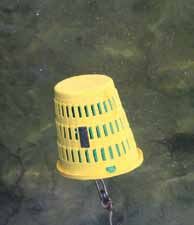 |
|
It is important to keep the |
The fish will respond to many different types of burley quite well, from old fish frames, to fish-based cat foods, bread, cooked rice, breadcrumbs, fish or chicken pellets or the pre-packaged we were using. The tuna oil serves two purposes, the first obviously is to set up a nice slick on the surface to entice the fish but it also helps the burley sink as it breaks the surface tension on the water. Something you must try to avoid is having burley floating on the surface because if you attract birds to the trail it can hamper your fishing efforts greatly as the birds will scare the garfish away. If after 15 or 20 minutes garfish don’t arrive in the burley trail it may be a good idea to move to another location and try again.
Jamie rigged a small soft tipped bait rod with a pencil float, about 50cm above a number 10 long shank hook. He baited this with a very small amount of squid just in the bend of the hook. He prefers long shank hooks as it’s easier to unhook the garfish but also to prevent bite-off from leather jackets and toad fish. The pencil float makes it easier to identify a take, some people prefer to fish without a float and just watch the bait drift back from the boat. A pair of polarised sunglasses can help in this endeavour. I rigged my 000 fly rod with a leader tapered down to two pound, a large, non-descript palmered dry fly with one pound tippet tied into the bend of the hook and a red grub pattern tied on a number 16 buzzer hook suspended under the dry. The idea was to be as sporting as possible hence the one pound tippet and light rod.
The slight movement of the boat in the water was enough to disperse the burley behind the boat in a nice slick. Within five minutes we started to see the fish dimple the water in the trail with their tiny billfish beaks breaking the surface. After fifteen minutes the school had grown to several hundred very eager fish. They were also accompanied by a large school of small mullet which tended to hang around very close to the burly bucket. My fishing companion was the first to be rigged up and flicked out his cast just half a dozen metres behind the boat. His unweighted bait slowly drifted down through the school and the garfish began to attack it with gusto. The fish tended to be quite small so Jamie missed the first few takes before he hooked his first fish. Giving the fish a little bit more time with the bait before he struck seemed to do the job. The fish jumped, splashed and barrel rolled as Jamie brought it to the boat, lifting it aboard. After unhooking the garfish he gave it a quick measure and found that it was just over 30cm.
 |
| Garfish are acrobatic little fighters. |
We both decided this would be a good cut-off size, with any fish smaller than that going back, the little ones being just too hard to clean. With his bait still intact Jamie flicked out another cast into the ever increasing school. With my fly rod rigged up I stripped line on the deck and rolled out a short cast to the leading edge of the feeding fish. My point fly, a little red worm pattern, slowly began to sink down amongst the garfish. With anticipation growing, I watched the fly as one after another garfish approached it and turned away refusing to take my small red offering.
However some of the fish closer to the surface were taking an interest in my dry fly but given that it was a fully palmered size 12 dry, some of the smaller fish were having trouble getting it in their mouth. It was quite comical to see them nibbling away at the fly as they pushed it round the surface in front of them. After a couple of false strikes I finally managed to hook my first garfish on the fly. After a very short but tentative fight I brought the fish to hand and unhooked it. With the garfish being less than 30 cm I released it and rolled out another cast.
After several fish ignored both flies I gave a short strip so that I could lift the fly line and flies off the water and put the flies back down in amongst the largest school of fish. As I started to strip the line a couple of fish charged and one fish took the small red worm pattern. I landed the fish, unhooked and slipped it into the ice slurry in the esky as this one was large enough to keep. With another cast into the school, the point fly again sank down amongst the fish with the usual lack of interest but as soon as I gave it a slow strip the fly was once again attacked. On this occasion I failed to hook the fish.
After a few more attempts I decided to change the point fly over for a tan coloured one, a pattern tied on the same size hook as the red one. The garfish seemed to take this far more readily as it was a closer match to the colour of the burley that the fish were feeding on. After a fish took either of the two flies I found it was better to give them a second or two to turn away and actually partially swallow the fly before I struck. Lifting the rod too soon seemed to come up with nothing on most occasions. With my drag set to its lowest setting to protect my light tippet, I found that some of the bigger fish were putting on quite a performance, at times taking quite a bit of line. I did find however that after catching three or four fish on the fly I would have to cut the fly off and re-tie as the garfish have quite abrasive mouths and would eventually chafe the line until it broke. I learnt this lesson after decorating my first garfish, probably not something that would happen very often.
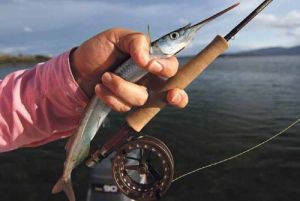 |
| Great fun on a light flyrod. |
Suffice to say that over the next couple of hours Jamie and I had a ball. We generally kept about every second fish that was slightly larger than 30 cm but we didn’t catch any over 35cm. In general the larger fish tend to turn up during mid to late winter and can be as big as 50cm and 500g in weight. It eventually came to the point where the school of fish were only one or two metres behind the back of the boat and were extremely aggressive, attacking anything that hit the water. With a sporadic by-catch of small mullet just to keep things interesting, it was quite a fun way to spend the afternoon while acquiring a good feed for the evening meal
After an hour or so the small mullet swimming around the burley bucket and feeding heavily were accompanied by several large specimens around the two pound mark. The thought of catching a mullet of this size on my tiny fly rod seemed like a good, fun proposition but try as I might I could not get the larger mullet to take the fly. Perhaps the fly was not a close enough representation of the burley they were feeding on. On my next outing I think I will take some cooked rice and add this to the burley mix as imitating a grain of rice with a fly would be very easy. I was so wound up in trying to get a larger mullet to take the fly, I failed to notice how late in the day it was. It was only after a few blunt hints that I noticed my fishing companion had packed his rods up, cleaned up the bait and was ready to go home. Jamie had done everything he could bar put on his PJ’s and wind up the alarm clock!
Garfish can be caught anywhere around our coasts but are more easily targeted in our estuaries from late autumn through until mid September. As well as being targeted using bait and fly tackle they can also be taken on light bream gear using 2 inch, light coloured, grub style soft plastics fished on light jig heads. Although it is easier to target the fish from a boat there are land-based options available. Any jetties, piers or rocky points that provide good access to seagrass beds over shallow water would be a good option. An offshore breeze from these locations can assist to carry your burley trail out from shore and bring the fish to you.
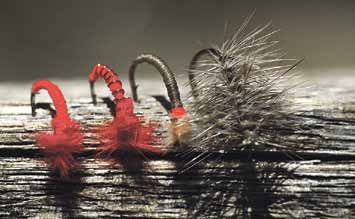 |
| A selection of the author’s flies. |
Catching garfish on a beautiful calm sunny winter’s day is a fantastic introduction to fishing for children or someone new to angling. The whole process can be kept quite civilised with a thermos of your favourite hot beverage, a comfy seat, a warm coat and tune the radio to the football. Tackle can be kept as simple as a light hand line, a cork and some small hooks. With the chance to exchange half a loaf of stale bread for a feed of garfish for the whole family, it seems like a good deal to me.
Simon-peter Hedditch


